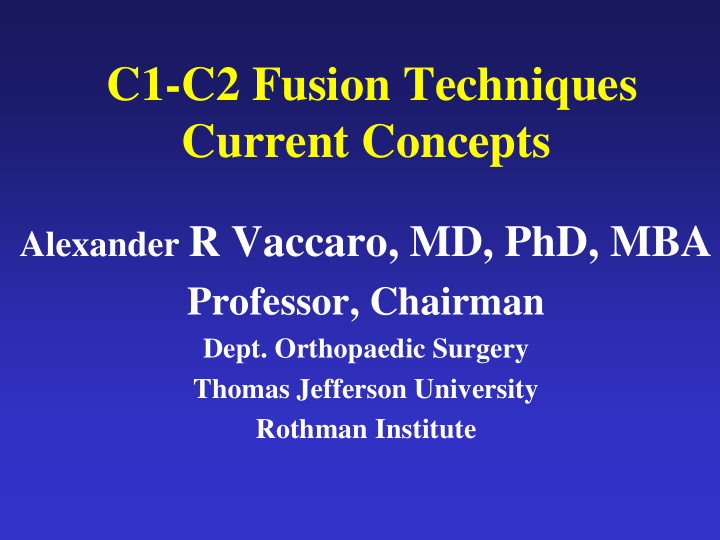



C1-C2 Fusion Techniques Current Concepts Alexander R Vaccaro, MD, PhD, MBA Professor, Chairman Dept. Orthopaedic Surgery Thomas Jefferson University Rothman Institute
Disclosure • Grant Support/ Royalties/Stock options/Consulting/Editorial Board: Depuy, Nuvasive, Medronics, Stryker, Globus, Stout Medical, Aesculap, Alphatec, Paradigm Spine, Replication Medica, Spinology, Bonovo Spine, Dimension Orthotics, Gamma Spine, IT, SBI, RI related holdings, Gerson Lehrman, Guidepoint Global, Medacorp, ISD, ASIP, PST, ICOM, Orthobullets, Vertiflex, Vexim, SpineWave, Atlas Spine, Avaz Surgical, AO Spine, Spine, ESJ, JNS, PSI • Board Member: CSRS • Editor in Chief : Clinical Spine Surgery • President: Rothman Institute
I NTRODUCTION • Multiple Options • Wiring • Hooks • Magerl Transarticular Screws • Harms C1 lateral mass -C2 pars/pedicle screw Technique • Translaminar E
Posterior Gallie Wiring
Posterior Brooks Fusion
Posterior C2/C1 Magerl Transarticular Screws
C1-2 Transarticular Screws • Vertebral artery perforation: 4% • Neurologic deficit: 0.2% • Wright, J Neurosurg, 1998 • Pre-operative CT with reconstructions • 18-23% may not be candidates • Sonntag,J Neurosurg, 1996
C1-2 Transarticular Screws • Starting point – 3mm cranial and 2mm lateral to the inferior edge of the inferior articular C2 process • Average screw length 40-45 mm • If vertebral artery injury do not attempt other side
Very steep angle needed: T1
Hooks
Anterior C2/C1 Screw Fixation
Anterior C2/C1 Screw Fixation
Anterior C1/C2 Screw Fixation
C1/C2 Lateral Approach
C1/C2 Lateral Approach
Anterior Transoral Plating
C1-2 Anterior Plating
C1 L ATERAL M ASS /C2 P EDICLE /P ARS S CREW Harms Technique: • 1 st described by Atul Goel with plates in 1994 • Popularized by Harms with Polyaxial screws & rods in 2001 Harms, Spine, 2001 Goel, Acta Neurochir (Wien), 1994
C 1 Lateral Mass Screw Two Options: 1.Thru Pedicle Analog 2.Below Confluence of post Ring
C 1 Lateral Mass Screw Two Options: 1.Thru Pedicle Analog 2.Below Confluence of post Ring
709 Specimens Measured For 3.5 mm screw: ARCH 14% feasible NOTCH 85% feasible 15% VA at risk even with Notch technique!!!
Below Confluence • Palpate Midpoint of LM with Penfield 4 • Burr 2mm drill seating Hong X, et al. Spine. 2004 Liu G, et al. Spine. 2008
Cranio-Caudal Angulation • Easy to violate Oc-C 1 Joint Avoid > 25 o Medialization - Aim for cephalad 20-40% of C 1 - Ant Tubercle Yeom, Spine J, 2009
Medial Angulation • Initially, straight ahead, now 10-15 o medial – To avoid ICA – Avoid > 25 o Medialization Hong X, et al. Spine. 2004 Wang M, Samudrala S. Neurosurgery. 2004 Murakami S, et al. Spine. 2008 Christensen D, et al. Spine. 2007
Bicortical C1 LM screws provide significantly better pullout strength Eck, JSDT, 2007
C1 ring- Internal carotid artery relationship Currier, Spine, 2008 • Highly variable location. Near the lateral edge of LM. Avg shortest distance from C1 anterior arch ~ 3mm. • Vulnerable with bicortical screws
Hypoglossal nerve also at risk Ebraheim,Surg Neurol, 2000 Located on the lateral border of lateral mass Just medial to the C1 transverse process C
Postoperative occipital neuralgia with and without C2 nerve root transection during atlantoaxial screw fixation Yeom, Spine J, 2013 PROSPECTIVE STUDY N= 24 consecutive N= 41 consecutive Transections Preservations ~20-30% worse neuralgia at every timepoint up to 2 yrs postop (significant at each timepoint except 1 month)
C2 root transection- necessary for joint distraction technique (Goel): 17 yo congenital anomalies and basilar invagination Goel, Neurol India, 2008
C2 Anatomy
C2 Posterior Screw Fixation Techniques • C2 Pedicle Screw • C2 Isthmus Screw • C2 Angled Isthmus Screw
Posterior C2 screw Fixation Techniques • C2 pars • C2 pedicle
Vertebal Artery Anomalies • Ectasia: 20% at least 1 ectatic artery • Prevents safe placement past isthmus • RA: high-riding VA more likely Paramore, J Neurosurg, 1996
Preoperative Assessment • Reformatted CT: • Adequate width of C2 pars interarticularis and pedicle
To determine feasibility of C2 pars screws: Evaluate the sagittal CT recon
To determine feasibility of C2 pedicle screws: Scrutinize axial CT scans
P ARS PEDICLE
C 2 Pedicle Screw • Start: lat on C 2 lateral mass • Palpate Isthmus • 15-45 o Medial – 28-35 mm screw – Longer when entering C 2 body • 30 o Cephalad
C 2 Pars Screw Pars screw less likely to injure VA • 0% vs. 0.3% with pedicle screws - Yoshida M, et al. Spine. 2006 Elliott RE, et al. J Neurosurg Spine. 2012 Abumi, et al. Spine. 1997
C2 Translaminar screws: Unilateral or bilateral Technically very easy to do No fluoro needed
Translaminar Screw Technique • Plan for 2 crossing screws – One very high, other low • Modifications – 2 ipsilateral, parallel screws Jea, Spine J, 2008 Sciubba, J Neurosurg Spine, 2008 Dorward, Neurosurgery., 2011
Biomechanics of C2 Translaminar screws: Claybrooks,TSJ, 2007 C2 Translaminar C2 Pedicle N=8 INSTRON testing F/E = = Transl = = Bend + Rotation +
C2 Translaminar screws: Best indications: Insufficient Pedicle or Pars due to medial VA aberrancy Salvage of failed Pedicle or Pars screws
C2 Translaminar screws: Downsides: Harder to hook up to longitudinal rod fixation (usually need offest connectors) May not have enough room for two screws in one lamina
Summary: Types of C2 fixation Pars Pedicle Translaminar Biomechanics ++ ++ + VA risk higher lower none SCI risk low low low but higher Anatomically feasible most pts most pts almost always Ease of rod hookup easy harder hardest
Crosslink
Thank You
Recommend
More recommend